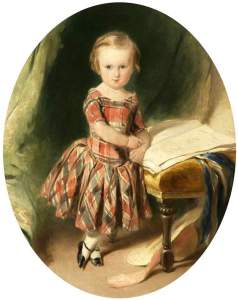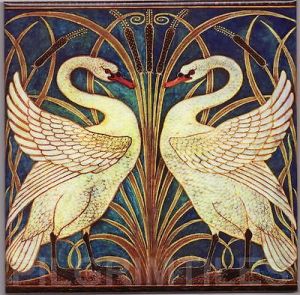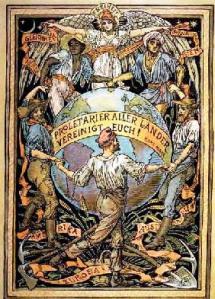Tags
Abolitionism, Arts and Crafts Movement, Declaration of Independance, Industrial Revolution, Mindset, Slavery, Socialism, The Gilded Age, The Haymarket Affair, Validation of Crafts, Wage Slavery, Walter Crane

Walter Crane by Frederick Hollyer, 1886 (Photo credit: Wikipedia)
I am closing this mini-series on art in 19th-century Britain, except for future posts on individual artists: Aubrey Beardsley, Kate Greenaway, Randolph Caldecott, as well as artists who illustrated their own texts, a foremost example being Beatrix Potter.

Walter Crane by his father Thomas Crane (Photo Credit: Wikipedia)
From Abolitionism to Socialism
- Immigrants to the United States
- The Declaration of Independence
- Wage Slavery
However, before closing, I can’t resist taking a closer look at Walter Crane who dared say the “Chicago four” (see Haymarket affair, Wikipedia) had been wrongfully convicted. His contracts were cancelled and he was shipped back to Britain.
As I read about Walter Crane, it occurred to me that slavery laid the foundation for wage slavery and that, consequently, there might be a link between abolitionism and socialism (labour unions).
Most immigrants to the United States were people escaping persecution, poverty, a change of régime, not to mention revolutions or other evils. There was no room in Europe for the Pilgrim Fathers and the Puritans, but there was land in what was or would become the United States.
However, among immigrants to the United States, there were persons seeking far more than the acquisition of a little white house surrounded by a picket fence. They were seeking the privileges that birth conferred upon European aristocrats, and which money might confer upon certain immigrants. Slavery had afforded nearly free wealth to plantation owners. Once a plantation owner had bought his slaves, wealth was within easy reach. Could the same not be done for industrialists?
In fact, the British had laughed when they read the text of the Declaration of Independence (4 July 1876). Britain was about to lose its better-located American colony, but as principal writer of the United States Declaration of Independence, Thomas Jefferson was seeking for the white what the black slaves could not attain and it so happened that Thomas Jefferson owned a large number of slaves.
If there were slaves, all men were not created equal. If there were slaves, the Creator had not endowed man with certain unalienable rights. Finally, if there were slaves, they did not possess a life of their own. They therefore had no rights and could in no way pursue happiness?
“We hold these truths to be self-evident, that all men are created equal, that they are endowed by their Creator with certain unalienable Rights, that among these are Life, Liberty and the pursuit of Happiness.”
I am inclined to think that Jefferson meant what he wrote, but that he was dependent on his slaves to the point of blindness and that he perhaps could not see the blacks as altogether human. He was unable to travel to France, where he spent several years, unaccompanied. He took slaves with him.
Therefore, it is possible that slavery had left in the American mind the thwarted notion that wealthy did not have to earn their wealth, which could serve to explain why an employer hired children and overworked employees he also underpaid. There was a ‘precedent:’ slavery. Workers were not owned, but why should they be paid adequately when the goal of the industrialist was to make as large a profit as possible. This could explain why Walter Crane, a socialist, made himself persona non grata at a gathering of polite society in Boston. Employers had rights: a profit.
It has been labelled wage slavery.

Design by Walter Crane (Photo credit: Google Images)
The Gilded Age
- a mindset
- wage slavery
- entitlement, or a “right” to
Slavery could be and was abolished, at a price: Abraham Lincoln was assassinated. But what could not be removed was a mindset. There was a precedent. Slaves had made the plantation owner rich, so factory owners would pay workers a less than adequate salary. Machines had increased productivity and so would employees.
“Increased mechanization of industry is a major mark of the Gilded Age‘s search for cheaper ways to create more product.” (See Gilded Age, Wikipedia.)
In other words, one type of slavery, the enslavement of the blacks, would be followed by another type: wage slavery.
“According to historian Steve Fraser, workers generally earned less than $800 a year, which kept them mired in poverty. Workers had to put in roughly 60 hours a week to earn this much.”
The Haymarket Affair
- Walter Crane driven out of the United States
- Socialism = Labour Unions
Consequently, abolitionism was followed by socialism or a degree of Marxism. After the Haymarket affair (1886), labour unions would develop. Employees paid union dues to be protected and it occurred to certain new Americans that they too could levy dues from businesses to ‘protect them.’
The Boston socialites who drove Walter Crane out of the United States may have been the wives of wealthy factory employers. In fact, they may have been the wealthy employers themselves. Yet, the social Walter Crane attended in 1891 was a Boston anarchist meeting. How could anarchists drive an artist out of a country? It seems that the expulsion of Walter Crane was a sign of things to come, a ‘precedent.’ A few decades later, McCarthyism arose.

(Photo credit: Google Images)
The Arts and Crafts Movement and Socialism
It should be noted however that although the Arts and Crafts Movement and William Morris are associated with socialism, William Morris owned a company and Kelmscott Press. Machines were used. They were not deemed useless; they were in fact very useful. Members of the Arts and Crafts Movement used machines. These increased the availability, at a reasonable price, of the various elements required to make a home beautiful: fabrics, wallpaper, decorative tiles, glassware, furniture, etc. Two stories merge: the Golden Age of Illustration, illustrations that could be reproduced, and the domestication of art, products that could be manufactured. However, Walter Crane was a member of the Art Workers Guild.
Almost immediately below, a photograph shows Morris & Co.‘s employees weaving at his Merton factory.
(See Arts and Crafts Movement, Wikipedia.)

The weaving shed in Morris & Co.‘s factory at Merton, which opened in the 1880s
Walter Crane: Women’s Clothing
- a woman’s health
- liberty
I forgot to mention that Walter Crane was a ‘clothes activist.’ He was “a Vice President of the Healthy and Artistic Dress Union, a movement begun in 1890.” (See Walter Crane, Wikipedia.) Women were forcing themselves into corsets and very tight clothes. Crane therefore militated against tight-fitting garments. Bless him! About two or three decades later, Coco Chanel started designing flexible clothes. Jersey was a fabric Coco Chanel loved.
Conclusion
The impact of the Industrial Revolution cannot be understated. Machines did the work, but our industrialists did not differ substantially from slave-owners. The goal was a profit even if the welfare of workers was put in jeopardy. A profit was a noble goal. People tend to have a good opinion of themselves and they may close their eyes if money is to be gained and even ill-gained.
Thus were born our labour unions.
With kind greetings to everyone. ♥
Walter Crane & Johann Strauss
“Roses from the South”

(Photo credit: Google Images)
© Micheline Walker
21 December 2015
WordPress


Now I hope we can move away from slave labour or wage slavery to a universal basic income. https://garethsworld.com/blog/tax-and-welfare/ten-types-people-better-off-unconditional-basic-income/
LikeLike
Gallivanta, This is brilliant. In the United States, people are starving. Here in Canada a mother who stays at home to raise her children does not accumulate a pension. It’s ridiculous. No wonder children are attracted to Islamic fundamentalism.
For the last six years I have lived on an income that can barely keep a person alive. Matters are improving beginning this January, when I can finally get money from a pension fund that is insufficient. I lived on disability benefits from 2002 to 2009. Unfortunately, disability benefits do not grow. They do not rise as does a salary, but should. Moreover, at age 65, one loses one’s fringe benefits: the dentist, eye glasses, etc. One has to pay everything out of pocket and I am now out of pocket because of unexpected expenses due to the fact that the co-owners of this building have never put money in a reserve fund. I have been trying to sell my share, but the person who buys it has to pay the total amount. He or she cannot get a mortgage. It’s an unbelievable story.
LikeLiked by 2 people
Our current systems are very unjust. We only seem to value people for the paid work they can do. We need to value people for all the many things they do, and realise that everyone can contribute to a richer, better society if given the right conditions and support. I am glad things will be a little easier for you in January.
LikeLike
Our current systems are indeed very unjust. My personal situation will improve significantly less than two weeks from now and I am capable of living humbly. However, I am making sure that people know my story. If I do not tell, what was done to me will be done unto others.
I have just learned that Canada has signed a 15 billion dollar contract to build tanks for Saudi Arabia. Saudi Arabia is one of the worst violators of human rights. The new prime minister cannot or will not cancel the contract. I can’t believe that we are part of the problem. That contract seals the fate of Raif Badawi. He is on a hunger strike and will probably die, but it will be a gentler death than the one to which he has been sentenced. He will not survive being flogged and he is to be flogged again, but not in public view. This is madness. My love to you and my best wishes.
LikeLiked by 1 person
Fascinating
LikeLiked by 1 person
A nation born in slavery. What a burden!
LikeLiked by 1 person
All so true. We are voting for Bernie Sanders,. We believe that is heart is in the right place, that he has a sense of justice, ethics, and fairness, and that he would help us to a better future for ALL, regardless or gender, sexual orientation, race, religion, social and economic class.
LikeLike
I think Bernie is the best candidate. He stands for equality. People are having a hard time.
Best wishes Naomi
May 2016 be one of your finest years.
LikeLiked by 1 person
Thank you, Micheline. Wishing you the best for 2016!
LikeLike
Thank you Naomi,
I’m wishing the best. The New Year, 2016, is an important year for the United States. Donald Trump as president! 🙂
LikeLike
A very important year, Micheline. I cannot believe that Trump could ever be taken seriously, but then I was absolutely floored when Ronald Reagan was elected. Am so disenchanted and discouraged with American politics. When Obama was elected, I cried tears of joy. He has done what he could against irrational and blind obstructionism, which Bernie Sanders will face if he is elected. Fingers crossed!
LikeLike
Naomi,
I don’t think he will be elected. But I can’t believe he has supporters. His racism (black) alone is revolting. I like Bernie Sanders, but I’m told he hasn’t a chance. Who knows? My very best wishes to you and your family. Micheline
LikeLiked by 1 person
Dear Micheline,
I am hopeful! Bernie is doing better and better in the polls. Thanks so much for your good wishes. Best to you as well!
Warmly,
Naomi
LikeLike
I’m also hopeful. Bernie is an unusual candidate, but he has a better understanding of the people of the United States than other candidates. He knows how a democracy works and he loves the people.
In 2008, Americans elected an African American to the presidency of the United States. He was reelected in 2012. Who would have believed this could happen?
One cannot underestimate the American mind. I’m cheering for Bernie. The friendship between the United States and Canada has never waned. Canada is not a powerful nation, but we are with you. Best wishes Naomi.
LikeLiked by 1 person